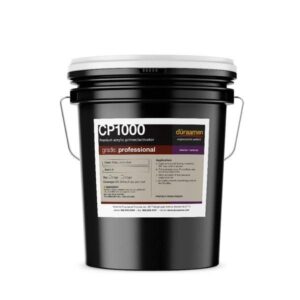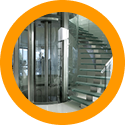Part 1 – Information & Preparation
general information
Kraftig is a three-component urethane concrete flooring system designed to protect concrete substrates from chemical corrosion, abrasion, impact, and thermal shock. Urethane Concrete flooring systems are suitable for food processing areas, production areas, bottling plants, commercial kitchens, pharmaceutical plants, sanitize/wash areas, and chemical processing areas.
The application of sealer is not required with Kraftig-SL, unless specified for cleaning or aesthetic purposes or for additional chemical resistance. A prime coat of Kraftig SC is recommended with Kraftig-SL to reduce the potential for outgassing craters/holes. The wearing surface for Kraftig-SL is smooth and easily cleaned under most process conditions. No priming is required for Kraftig-TG, a pigmented sealer is required.
surface preparation
Surface Preparation is the most critical portion of any successful resinous flooring system application. All substrates must be properly prepared as outlined in Technical-Bulletin-1.pdf. Specific attention should be paid to the following:
- Concrete Placement—an efficient vapor barrier should be directly under slabs on or below grade to prevent moisture migration
- Curing and Finishing techniques of the concrete substrate
- Age of concrete
- Previous contamination of the substrate
- Present condition of the substrate
- Make sure the floor is free of moisture vapor transmission
Also, the temperature conditions of the area to receive the flooring system should be checked. An optimum room temperature of 75°F with a slab temperature of 50°F is required for proper cure of the resin flooring system.
special conditions
Do not apply in temperatures below 45°F, above 85°F, or if relative humidity is above 85%. To extend working time in hot temperatures, consider cooling the Part I and Part II resin components in ice water or cold storage. Do not apply to sand-cement screeds (tile setting bed mortars), asphaltic substrates, glazed tile or brick (unless glaze is mechanically abraded), copper, aluminum, softwood, or existing coatings of epoxy, polyester, or urethane. DO not apply to wet concrete or to polymer modified concrete with moisture content above 10%. Do not apply to concrete if air temperature is within 50°F of dew point.
material quantities
One unit of Kraftig-SL contains
Part I – 1 gallon
Part II – 1 gallon and
Part III – 44 lbs
Coverage – 20 ft² at 1/4″, 30 ft² at 3/16″, 40 ft² at 1/8″ thickness
One unit of Kraftig-CO contains
Part I – 1/2gallon
Part II – 1/2gallon
Part III – 7lb (Filler Powder)
Coverage – 100ft² per unit at 12mil thickness
Note: The Part III (filler powder) is packaged in 50 lb bag and must be weighed out in 7lb portions at the jobsite or measured out by volume…7lbs of filler powder is approximately 1gallon by volume.
Part 2—Priming
Note: If cove base is specified, use Kraftig-CV for solid color or Perdure E10-CV with Kwotz for Kraftig-Kwortz system. Trenches should be lined with Kraftig-CV.
priming
For Kraftig SL flooring system, prime with Kraftig SC (@ 100-125 ft²/kit) to reduce out gassing pinholes in Kraftig SL bodycoat. Allow Kraftig CV to cure minimum 6 hours before applying Kraftig SL.
The recommended application between temperatures is between 50°F and 70°F with relative humidity below 85%. Mechanical mixing is required.
Part 3—Application
mixing
- Add equal parts of Part I and Part II in the mixing container and blend for 30 seconds. Add the pigment pack (except neutral color used with quartz) to the Part 1 prior to mixing.
- Add Part III slowly to the mix (while mixer is running) and allow to blend for 3-4 minutes. Be sure to ‘wet-out’ all parts of mix, scraping sides and bottom of mixer during mixing. All powder must be uniformly blended with no visible lumps of dry powder. Mixing bucket and mixer of blades should be scraped out thoroughly and cleaned with solvent (acetone, MEK or Xylene) every few batches or working time on subsequent batches may be shortened. If missing in a plastic bucket, dispose of bucket after 3-4 mixes and replace with a clean bucket.
Set up mixing station as near to the work area as possible. Exothermic heat will be generated and flash setting may occur if material remains in the pail too long. Do not mix more than can be used in 10 minutes.
application
- Place mixture on floor and spread with a gauged straight edge (gauge rake set 1/16″ higher than desired thickness), flat trowel or 1/2″ V-notch trowel (for application rate of 40 ft²/kit). A “V-notched”e trowel will not level without a loop roller. Leave a ‘wet line’ of puddle of material between batches to avoid ‘knit-lines’ in the finished system. Maximum working life is 15 minutes at 70°F, less than 10 minutes at 80°f +. To extend the working life 5 minutes, add 5-10% Isopropyl Alcohol to the urethane resin during mixing, prior to adding the provider. Cooling the resin components prior to use is a more effective method in very warm temperatures.
- Back-roll the surface lightly with a loop roller while material is still wet. To minimize marks in the finished system, the controller should wear ‘spiked’ shoes while walking on wet material. Keep roller cleaned with Isopropyl Alcohol.
- Kraftig SL and Kraftig Kwortz only: Broadcast colored quartz or silica sand to excess into each batch of material immediately after loop rolling. Allow to cure minimum 8 hours. Sweep and vacuum excess granules, apply recommended topcoat(s) as required. A second broadcast is recommended for Kraftig-SL Kwortz. Use recommended epoxy resin binder for the second broadcast. Follow mixing and application instructions for the specific epoxy resin used.
Part 4—Application of Top Coat / Termination & Repair
mixing
- Add equal parts of Part I and Part II to mixer and blend for 30 seconds. Add the pigment (except for neutral color) to the Part 1 prior to mixing.
- Weigh out 7 lbs (about 1gallon) of Part III powder and add slowly to the mix (while mixer is running) and allow to blend for 3-4 minutes. Be sure to ‘wet-out’ all parts of mix, scraping sides and bottom of mixer during mixing. Ll powder must be uniformly blended with no visible lumps of dry powder.
application
- Place mixture on floor and spread with a squeegee to a coverage rate of 100 ft²/kit (or as otherwise specified) and immediately backroll lightly with a loop roller. Keep roller cleaned with isopropyl alcohol. Do not backroll the material excessively.
- Leave ‘wet line’ or puddle of material between batches to avoid ‘knit-lines’ in the finished system. Maximum working time is 10-15 at 70-75°F. To extend the working life 5 minutes, add 5-10% Isopropyl Alcohol to the urethane resin during mixing, prior to adding the powder.
Termination points at the end of the day should be made at doorways, expansion joints, etc. If it is not possible to terminate at these points, 2″ masking tape should be placed in a straight line at the ending point. Carefully trowel the material up to and slightly over the inside edge of the tape. Allow material to cure for about 30 minutes and remove the tape.
Terminations, Crack Repair, Joint Treatments
- All free edges (perimeters, terminations adjoining cove base or control/expansion joints, or along gutters or drains) require ‘keyed in’ extra anchor to distribute mechanical and thermal stresses. This can be achieved using a chipping hammer or saw.
- All expansion joints must be exposed through the system. Control joints (saw cuts) and cold joints should also ideally be exposed through the Kraftig but may be overlaid if the facility owner accepts that future telegraphing cracks may develop if expansion/contraction movement occurs in the substrate joint. To overlay a control joint, fill with rigid epoxy (Perdure EJF), Kraftig SL or Kraftig SC. Consult with your technical representative on the use of flexible epoxy crack isolation membrane as a surface treatment for overfilled control joints and cold joints. Do not overlay expansion joints.
- Cracks: Route cracks larger than 1/16″ and fill with rigid epoxy, Kraftig-SL or CO and reinforce with minimum 12″ wide fiberglass cloth. Consult with your technical representative on the use of flexible epoxy crack isolation membrane as a surface treatment for overfilled cracks.






